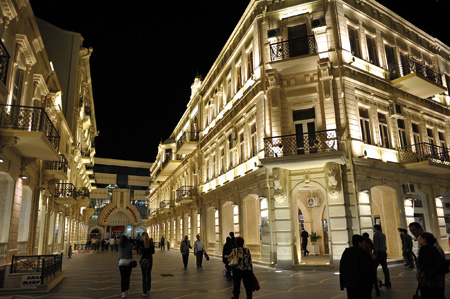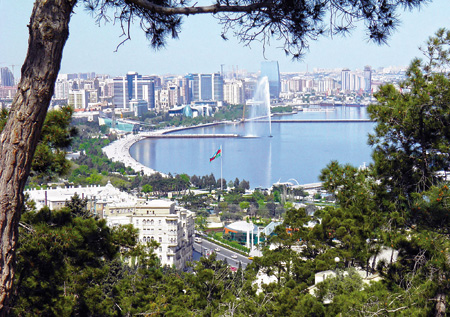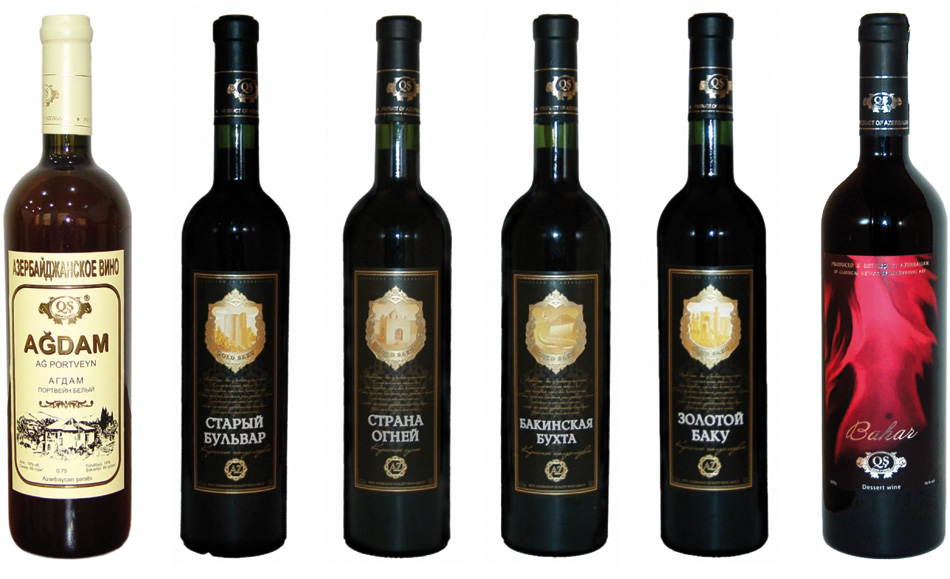Monde Azerbaijan
Azerbaïjan :
land of fire but also land of wine Called “Land of Fire” by the Ancient Zoroastrians, Azerbaijan is the largest of the 3 states of South Caucasus, bordering the Caspian Sea. Of a surface comparable to that of Portugal, located between Asia and Europe, it constitutes a bridge between the 2 continents.
Crossroads between East and West on the Silk Road, various races and religions coexist since the ancient times in an exemplary tolerance there, generating a vast cultural, artistic, historical and economic heritage. Fallen under the charm during the journey he had made there in 1858/59, Alexandre Dumas widely praised its natural and culinary resources in his book
“Le Caucase”.
 New vineyards in the Caucasus
New vineyards in the Caucasus After a very rich Palaeolithic, antique and medieval history, this country is experiencing since its independence in 1991, a real economic, agricultural, industrial and sociological revolution, according to a beautiful formula:
“Black Gold and Grey matter”. It is one of first world producers of oil and gas through the Caspian Sea - in fact the biggest lake of the world - which allowed it to fit comfortably into the modern era with a well mastered growth, without suffering from the last world financial crisis.

Baku by night
Baku (city of the wind), the capital, located on the shores of the Caspian on the Apsheron peninsula, with a very mixed architecture of Haussmann style with an arabic-eastern influence combined with a futuristic European urbanism “Dubai-style”, and with a certain charm for his strengthened old town, will become the largest business and financial pole of the whole Caucasus /Central Asia area, crossroads between Europe and Asia.
The sector oil/gas being situated only on the edges of the Caspian Sea, all the rest of the country is agricultural and artisanal. It is a real mosaic of multiple microclimates with varied soils fertility and different altitudes. And so the vine became established in the central and north part along the axis Baku/Ganja-Gazakh and Ismayilli-Zagatala.
This zone is well protected from the North winds by the Caucasus. True natural frontier under Mediterranean influence through the corridor Caspian Sea/ Black Sea, it is ideal for vineyards.
The best production areas of Azerbaijan are: Ganja, Goy-Goyl, Shamkir, Tovuz, Agstafa, Gazakh, Sheki, Ismayilli, Zagatala, Shamkhi, Agdam, and Nagorno Karabakh.
The chiefs of the ancient peoples Azerbaijanis were moreover all involved in grape growing, as evidenced by numerous archaeological excavations. Experts believe that viticulture in Azerbaijan dates back at least 7,000 years. The vines grew already in all territories, from the foothills of the Caucasus to the sands of Apsheron.
With a return on more contemporary history, during the Soviet era, Azerbaijan was one of the major republics of USSR to elaborate wines. At that time there were 300,000 ha of native varietals producing wines rich in alcohol, sweet and without qualitative character. In 1985, with the anti-alcoholic politics of Gorbatchev, all the vineyards were uprooted and the cellars destroyed. But after the independence, the government set up a vast campaign of replantation of the vineyard, partially to bring back a big agricultural vocation, but also for the country economic development in addition to oil and gas. Thus with 9.500 ha transplanted in 2005, 18.000 ha this day, and a plan of 10.000 ha until 2013, Azerbaijan is going to return to its roots and vitivinicole authenticity.
Azerbaijan was very rich in native vines with more than 200 varieties of white wine grapes and dessert grapes: Ganja, Bayanshira, Agh Shany, Agh Kismishi, and red grapes: Madrasa, Shirvanshahi, Khindogny, Gara Shany, Shamakhy, Merendisi, Hamashara, and Gara Kismishi.
Only the best have been kept: Saperavi, Madrasa, Rkatsiteli, Baian Shirei, and associated to imported varietals: Chardonnay, Sauvignon, Cabernet Sauvignon, Merlot, and Syrah (here called Shiraz).

View of the capital city of Azerbaijan, Baku and its fountain
Besides, with a Western-like policy of planting density and yield (6/8 t/ha instead of 10/15 t/ha and more during the Soviet era), we discover now Azeri wines of a high quality with a beautiful sensory expression, mono or bi-varietals, sometimes associating Azeri and French grape varieties. It is a very big reconversion, in mind of the modern vine growing that leads now Azerbaijan in the circle of the new producing countries of the Old World.
This willingness of European recognition is confirmed this year by the victory of Azerbaijan at the 2011 Eurovision Grand Prix.
Claude SAMSON
Crédit photos : Ambassade de la République azerbaidjanaise en France




